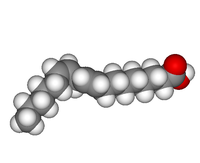
Photo from wikipedia
Prostanoids and leukotrienes (LTs) are representative of ω6 fatty acid-derived metabolites that exert their actions through specific receptors on the cell surface. These lipid mediators, being unstable in vivo, act… Click to show full abstract
Prostanoids and leukotrienes (LTs) are representative of ω6 fatty acid-derived metabolites that exert their actions through specific receptors on the cell surface. These lipid mediators, being unstable in vivo, act locally at their production sites; thus, their physiological functions remain unclear. However, recent pharmacological and genetic approaches using experimental murine models have provided significant insights into the roles of these lipid mediators in various pathophysiological conditions, including cutaneous inflammatory diseases. These lipid mediators act not only through signaling by themselves but also by potentiating the signaling of other chemical mediators, such as cytokines and chemokines. For instance, prostaglandin E2 -EP4 and LTB4 -BLT1 signaling on cutaneous dendritic cells substantially facilitate their chemokine-induced migration ability into the skin and play critical roles in the priming and/or activation of antigen-specific effector T cells in the skin. In addition to these ω6 fatty acid-derived metabolites, various ω3 fatty acid-derived metabolites regulate skin immune cell functions, and some exert potent anti-inflammatory functions. Lipid mediators act as modulators of cutaneous immune responses, and manipulating the signaling from lipid mediators has the potential as a novel therapeutic approach for human skin diseases.
Journal Title: Immunological reviews
Year Published: 2023
Link to full text (if available)
Share on Social Media: Sign Up to like & get
recommendations!